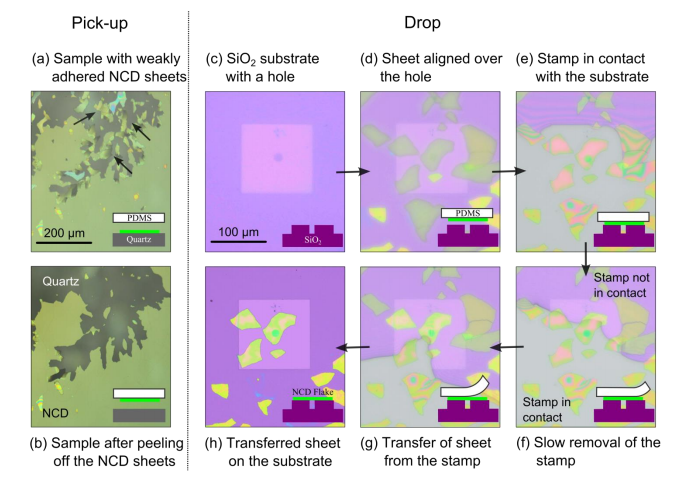Nanosheet Handler Heralds New Era of Diamond Age Devices
Diamond films are among the most extraordinary materials on the planet. They are strong, transparent, and conduct heat well. They are biologically inert but can also be chemically functionalized by attaching molecules to their surface. What’s more, when doped, they become semiconductors and so can be used in electronic circuits.

So it’s no wonder that materials scientists are licking their lips at the prospect of incorporating this wonder material into more or less any device they can think of.
But there’s a problem. Diamond films have to be grown at high temperatures in an atmosphere of pure hydrogen, which is not compatible with the way other microdevices are made, such as silicon chips.
So a useful trick would be to have a way to make diamonds films in one place and then transfer them to another so that they can be placed onto chips and other devices.
Today, Venkatesh Seshan at the Kavli Institute of Nanoscience in the Netherlands and a few pals say they have perfected a way to grow diamond films on a quartz substrate, separate the films and then pick them up and place them somewhere else.
The team begins by placing nanodiamond seed crystals on the quartz surface and heating it to over 500 °C in a hydrogen plasma atmosphere. The seeds then grow, creating a crystalline diamond surface up to 180 nanometers thick.
The team has perfected a novel technique for releasing the diamond film from this substrate. During the growth, these materials expand at different rates creating stresses that split one layer from the other. “The conditions were purposefully chosen so that at a thickness of ~180 nm, this stress is sufficient to crack the film and to delaminate it from the quartz surface, forming numerous nanosheets,” say Seshan and co.
The team uses an optical microscope to identify the nanosheets and then lift them off using a sticky film, rather like picking up graphene sheets with Scotch tape. The sticky film is then positioned over the device, such as an electronic circuit, and then pressed into position. The team removes the sticky film by slowly peeling it off the nanosheet, a process that takes up to 10 minutes.
Seshan and co have tested their technique by creating a number of diamond nanosheet–based devices. These include drum-like resonators, an electronic circuit and even place the diamond sheets on top of other material sheets to show how it should be possible to create entirely new materials made of alternating material layers.
That’s handy because the team can then characterize the way nanodiamond films behave in a range of new situations. It also opens the way for its use in a wide range of other applications.
There is a caveat, of course. Identifying the nanosheets and positioning them is a time consuming process. So this technique will never be useful for mass producing diamond-based devices.
That will have to wait for the development of a technique to do the positioning automatically and in parallel on a massive scale.
But with machine vision techniques developing rapidly, it may be possible to take humans out of the loop in the near future. The massive parallelization of this kind of manufacturing technique will take more work, however.
The potential is clear. This kind of work could usher in a new kind of technology to complement the silicon and graphene ages we are currently experience. In other words, start looking forward to the diamond age.
Ref: arxiv.org/abs/1503.02844 : Pick-Up and Drop Transfer of Diamond Nanosheets
Keep Reading
Most Popular
Large language models can do jaw-dropping things. But nobody knows exactly why.
And that's a problem. Figuring it out is one of the biggest scientific puzzles of our time and a crucial step towards controlling more powerful future models.
The problem with plug-in hybrids? Their drivers.
Plug-in hybrids are often sold as a transition to EVs, but new data from Europe shows we’re still underestimating the emissions they produce.
Google DeepMind’s new generative model makes Super Mario–like games from scratch
Genie learns how to control games by watching hours and hours of video. It could help train next-gen robots too.
How scientists traced a mysterious covid case back to six toilets
When wastewater surveillance turns into a hunt for a single infected individual, the ethics get tricky.
Stay connected
Get the latest updates from
MIT Technology Review
Discover special offers, top stories, upcoming events, and more.